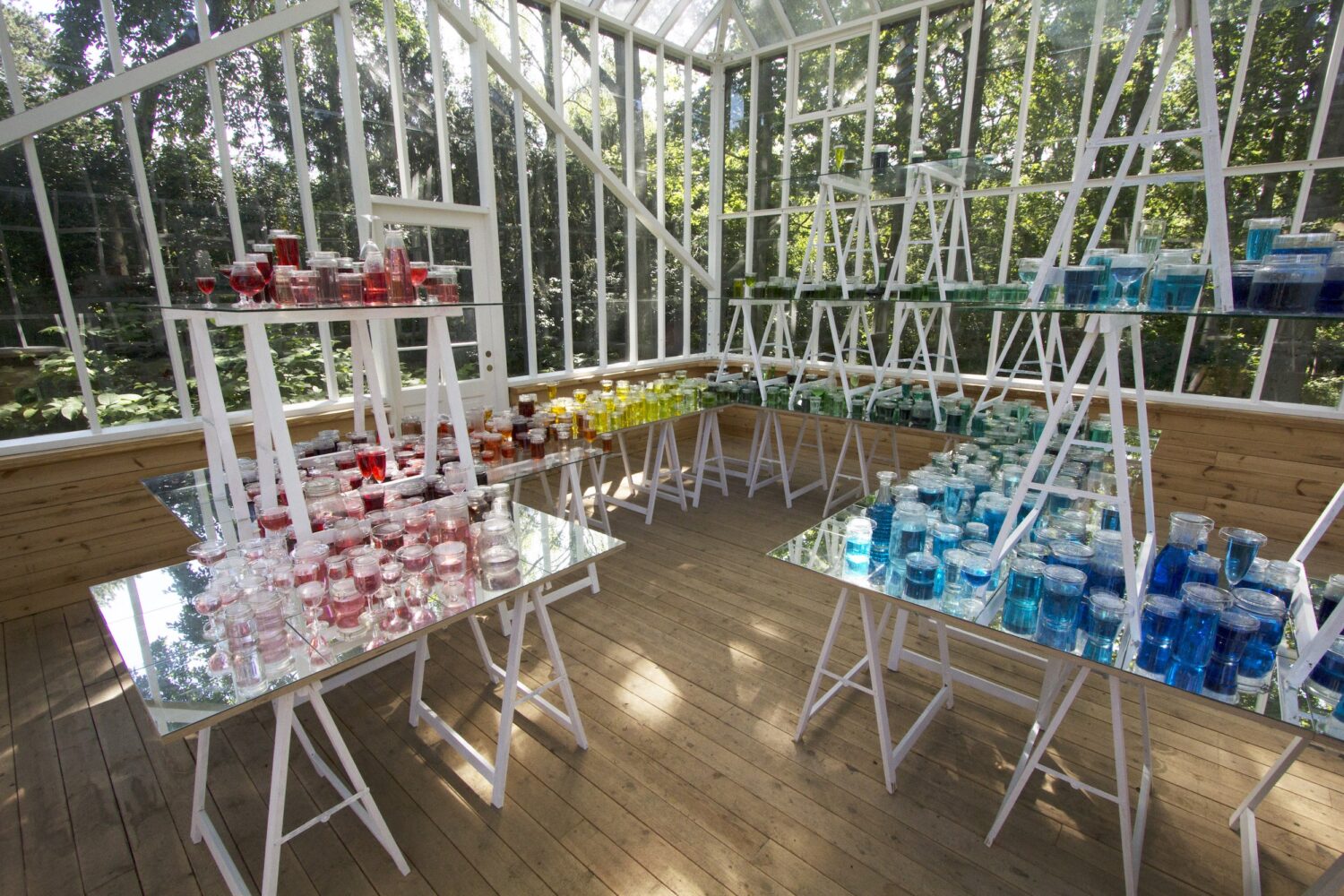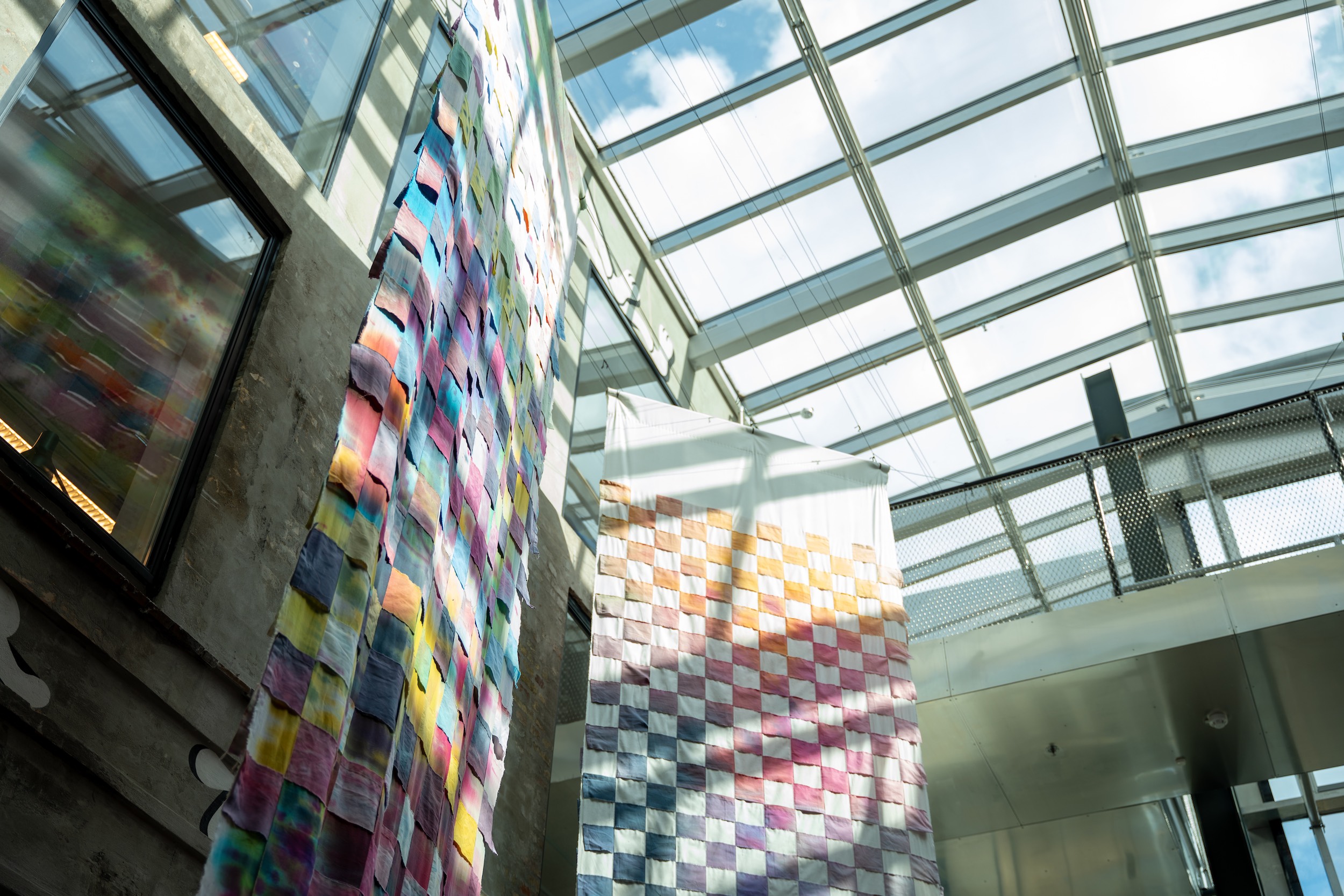‘The finished works are not really the main thing here,’ says Sofia Hagström Møller on the staircase surrounded by the three woven webs hanging seven metres down from the skylight, like rainbows going astray, through the stairwell between the new and old library buildings. The three textile webs connect the floors, and the colours point to the graffiti on Ungdomshuset, which can be seen through the windows behind the stairs.
The three woven works are the most visible result of an artist-in-residence project between weaver and textile artist Sofia Hagström Møller, Rentemestervej Library, which on its website also calls itself “a cultural hub for the Bispebjerg district”, and three schools from Copenhagen and the surrounding area: Engstrandskolen, Hareskov School and FGU Østerbro – the design and recycling programme.
Sofia Hagström Møller
Sofia Hagström Møller is a weaver and textile artist, graduated from the Royal Danish Academy of Fine Arts in 2007 with an MA in Textile Design. She teaches and develops new textiles with both analogue and digital looms, but above all she creates unique woven works with sculptural qualities. She has realised decorations in public spaces and participated in art exhibitions in Denmark, Sweden, USA, Italy, Slovakia and France.
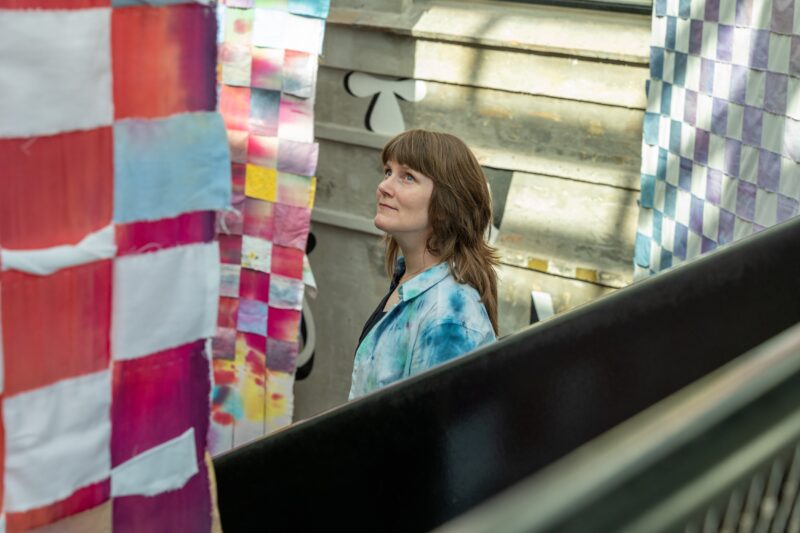
Sofia Hagström Møller went into the project with a clear plan not to have a predetermined product as a goal. And that was also the agreement with the host library from the beginning. The library and its daily users could not expect a decoration. It was the cultural encounter between the weaver and the young people that was crucial.
The library staff opened all rooms and workshops for the project, which unfolded in three different artistic processes. And three equally different woven works.
It would not have made sense to describe the final works in advance, as there would not have been room for the artistic development of the young participants that Sofia Hagström Møller wanted:
‘The textile tracks in the room have turned out better than I could ever have imagined. But it’s the sketches, the process, that is the work itself. It’s the basis for the final works. I would have been happy with a good collaboration with the three classes and an exhibition of posters with sketches and samples.’

Research: Putting words to a cultural encounter
Sofia Hagström Møller described the process in the invitation she and the library sent to the three schools, Engstrandskolen, Hareskov School and the slightly older students at FGU Østerbro – the design and recycling programme. The classes that wanted to participate in the house artist project would spend four full days with the artist and together they would explore the theme ‘Contrasts meet’ through typical phases of an artistic process: one day of research; one day of experimentation and investigation; and two days of production.
On the first day, the young people collected impressions from the library as part of their research and formed pairs of contrasting words: high/low, cold/warm, inside/outside. One group came back to the workshop and reported: ‘There is not a single book on weaving here’ – in contrast to Sofia Hagström Møller’s presentation on the ubiquity of textiles.
But although textiles and weaving are all around us, and a weaver can see patterns everywhere, the construction principles of weaving only become easy to understand when you try to weave in a handheld and simple way. And you can do that without a loom or thread.
On day three of the course, Sofia Hagström Møller handed out strips of paper in different colours so that the young people could work their way into the logic of the weaving pattern with paper weaving. For paper weaving, the principles of intersecting thread systems, trend and interlacing make a flat image that can easily be varied into different patterns without any technical weaving skills.
‘The fact that not a single person in a school class has woven before; I’m used to that. But some of the young people had never used the library before. On the other hand, I hadn’t worked with words in my process in this way before. So for me as an artist, there has been learning on many levels in this project’s cultural encounters,’ says Sofia Hagström Møller.

Experiment: Blue, yellow and red textile colour in the hands of a school class
The three classes went through the same process with slight variations. On the second day, they worked with dyeing directly on the long textile webs, because Sofia Hagström Møller refused to both use ‘test cloths’ and give long introductions to colour theory. The impact of colours on each other, she believes, is something you have to experience: ‘It’s important to work on the final material so that the process becomes visible and tangible. It was great fun and a lot of work, and the workshop was filled with colour!’ All three classes had the same basic colours and materials to work with in their artistic exploration and production. The contrast is therefore striking to observe in the three finished weavings.
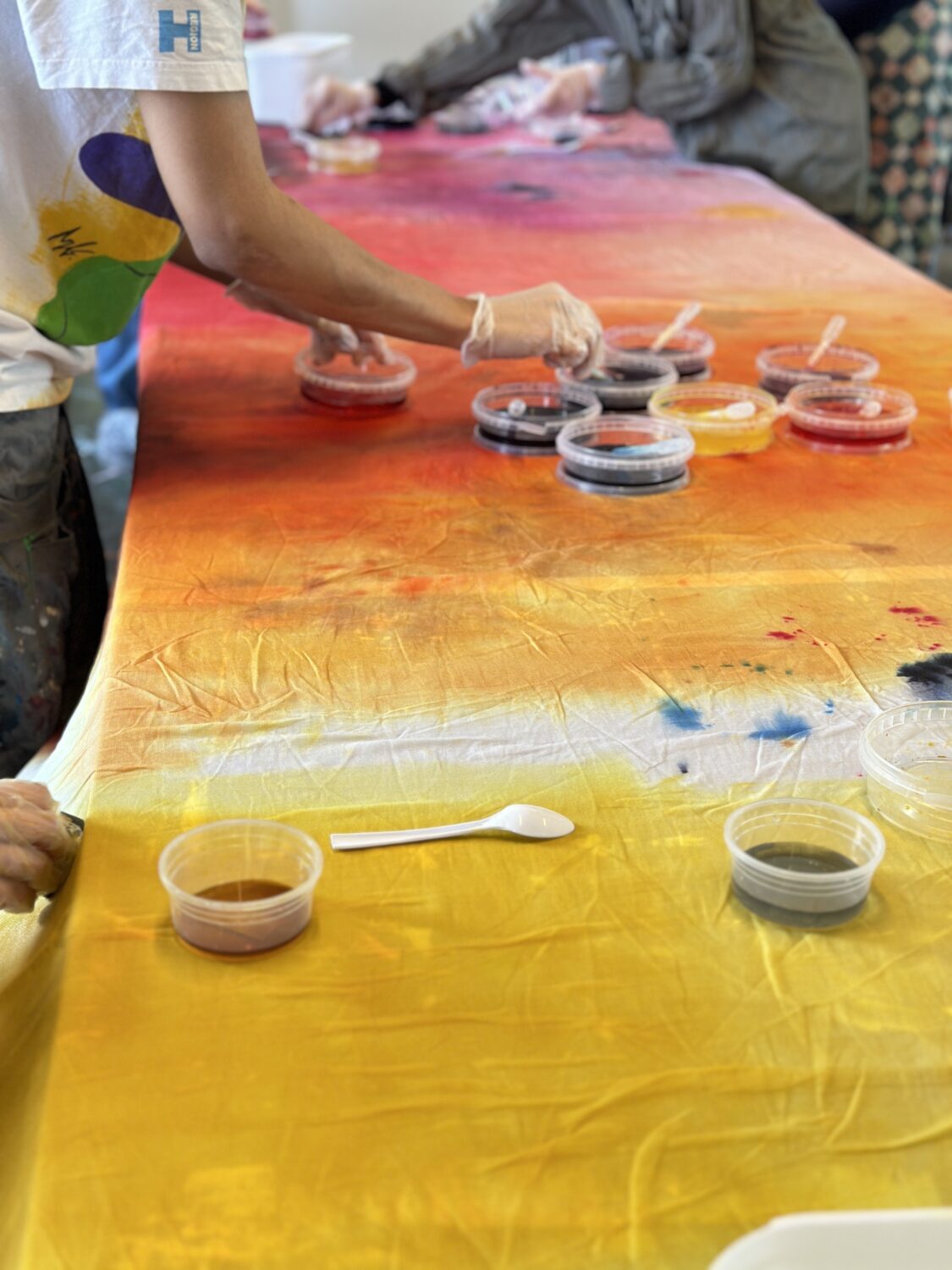
One banner has a sliding colour gradient where orange is followed by yellow, which turns to pink and is followed by purple and then blue-green shades. It’s the ABCs of colour theory, flowing seamlessly down the banner and illuminated by white squares from the intersection with transverse strips of undyed fabric.
The second banner has patches of blue and yellow running together to reveal themselves as green and speckled with complementary red, which blends into brown and is then replaced by white checks, delicate yellow gradients, concentrated dots and drenched purple blends before saturated fields of colour within and across the checks finally give colour dominance over the weave pattern.
In the third weave, the colour mixtures trickle down from top to bottom of the continuous banner as shades of pink, yellow and green. The colour sequence is rhythmically interrupted by a pattern of double-height white checks and transverse watery contrast colours. Unlike the other two banners, this one has woven-in twisted bands that emphasise the textile material of the woven structure as an extra dimension.
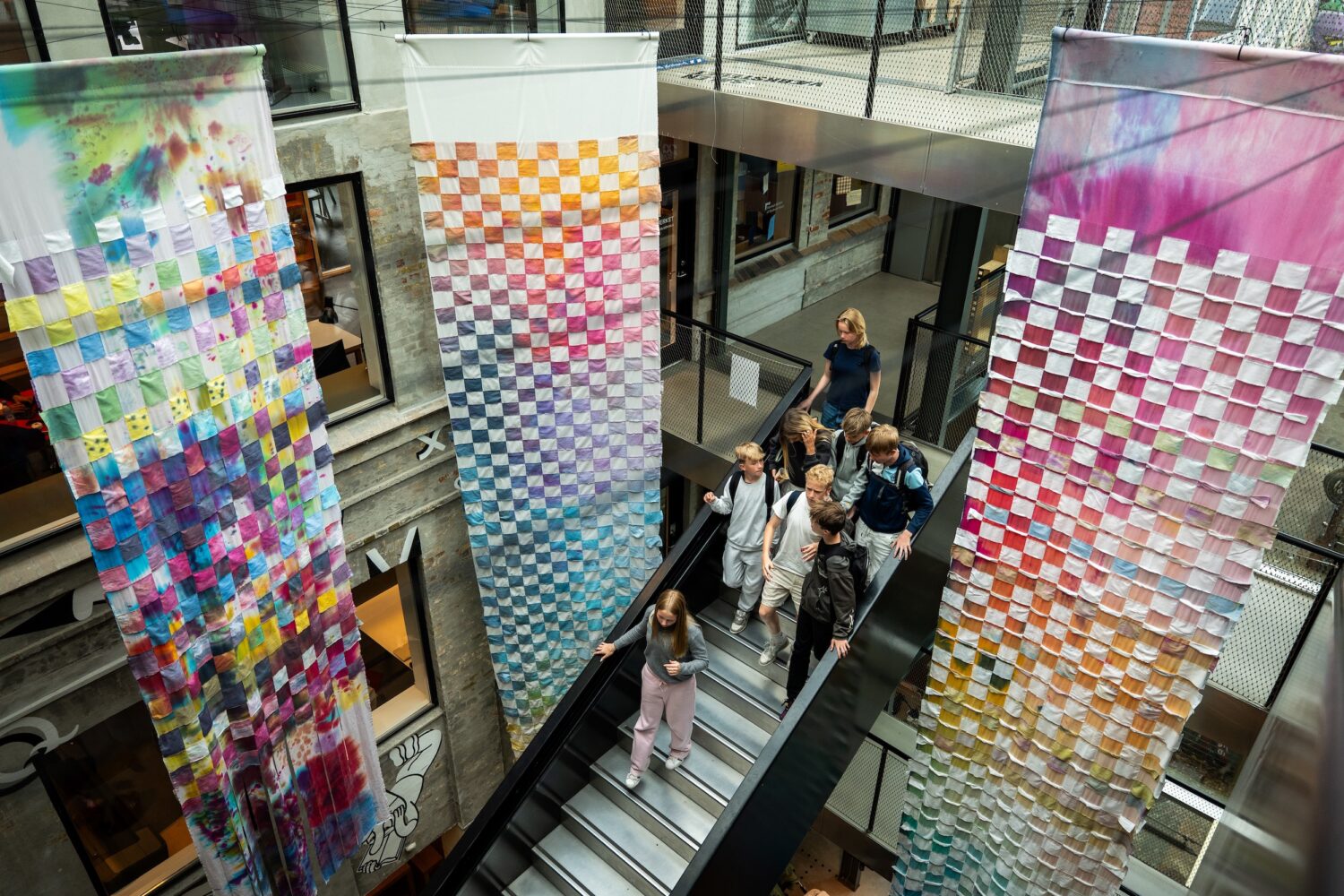
Production: A human loom with many arms must find a way to work together
‘Weaving textile structures in colour is an ideal way to visualise a cultural encounter,’ says Sofia Hagström Møller, who experienced it as a cultural encounter in itself to get so close to the three very different groups of children and young people.
Some had good experience of smooth collaboration, but found it challenging to experiment their way to a previously unknown goal. The artistic process leads along winding paths to something new that didn’t exist before you started. This is difficult to convert into learning objectives and for some students difficult to understand. They asked: ‘Why are we doing this?’ says Sofia Hagström Møller, who, on the other hand, experienced other students entering the workshop with an expectation of being left out. So it made an impression on her to see one of the boys, from whom no one expected engagement, working for a long time in full concentration on drawing.
During the actual weaving, all students had to engage very directly: The students were the loom itself, with some lifting the long webs in shifts – the trend – and others weaving the transverse webs in between. ‘Can we take a break now?’ Sofia Hagström Møller remembers hearing from someone with her arms and the strips of fabric hanging limply down. But the rest of the young people replied ‘yes, we have to keep going, we have to see this through!’ – ‘And then it just kept going.’
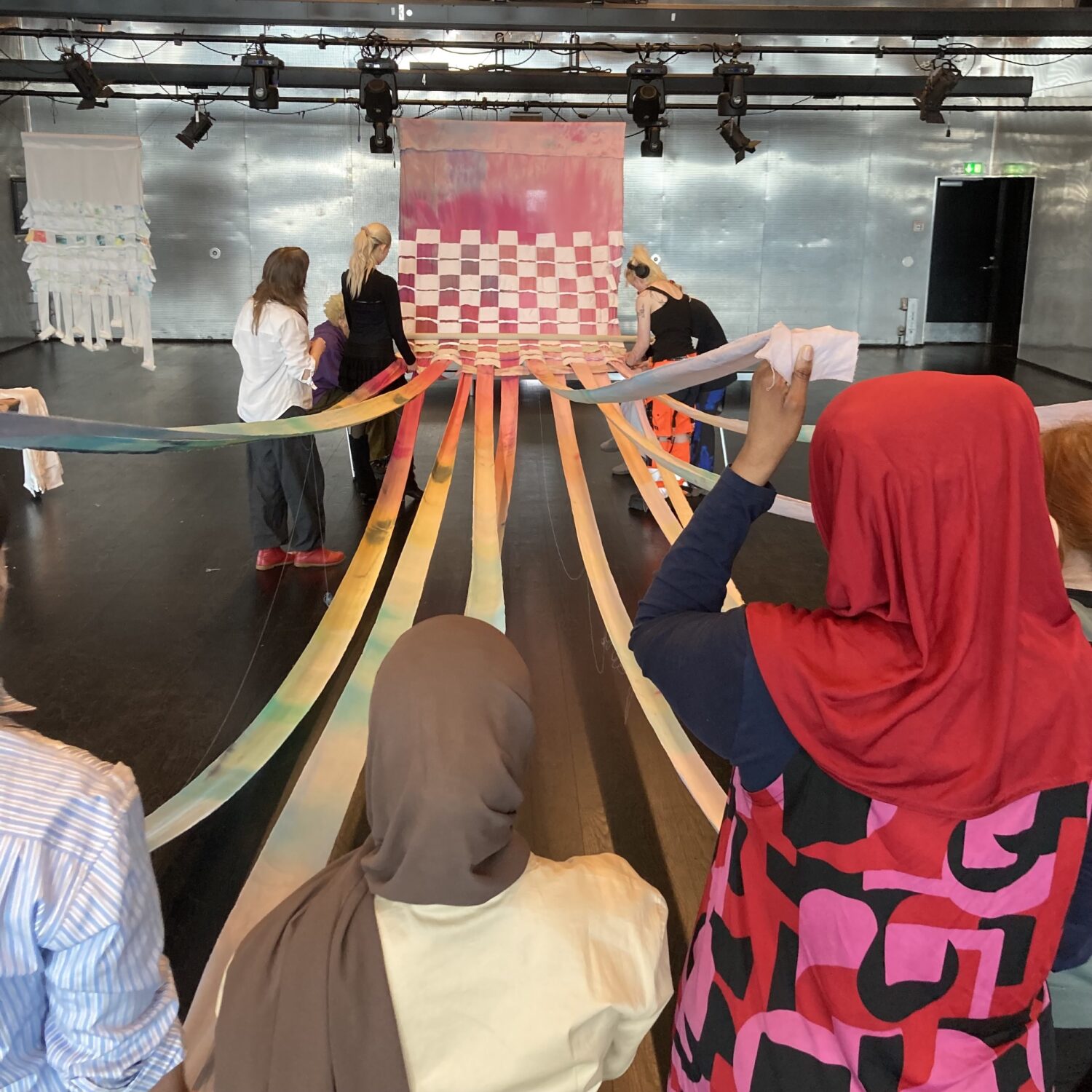
She elaborates: ‘Even the young people who had an easy time with artistic development were not used to working together on artistic production. But with the long lines that need to be woven together, you have to collaborate, and I actually didn’t realise how much of an effect it would have. But it was the young people themselves who said: ‘Now we have to keep working together! We need to be displayed in the big room.’
Exhibition: If they had come, I would have told them it was their work
The process may have been the essential part of the house artist project, but on the day of the opening, Sofia Hagström Møller realised how important it is to be able to participate in a public presentation of a collaborative artwork. She had prepared an opening speech thanking all the young people taking part. She saw that some of those who attended had their families with them and were clearly proud. Others showed up but stayed on the periphery and avoided entering the centre of the typical buzzing opening, where guests gather and chat animatedly. A large group never turned up on the opening day to see the finished works hanging in the stairwell.
‘And it was probably those who needed the recognition the most who didn’t turn up,’ Sofia Hagström Møller speculates. They may have seen the works on display at the library during the summer, but regardless, she will give the acceptance speech again when the works are hung up in the classes’ respective schools. And the in-house artist is considering whether openings, like an artistic process, can also be designed in new ways that provide more diverse opportunities to participate: ‘There has also been a lot of learning in this process for me’.
About the project
The artist-in-residence project Contrasts Meet was realised in 2024 by Sofia Hagström Møller at the library on Rentemestervej in Copenhagen NV with support from the Danish Arts Foundation. Three classes from Engstrandskolen, FGU Østerbro – the line for design and recycling, and Hareskov School participated in the project and produced three works with used textiles from material sponsor Elis Danmark.
Sofia Hagström Møller has produced a short film about the house artist project with photographer Martin Yam Møller:: https://youtu.be/WnoFttqlc9M?si=lcgobk465N8rntPL
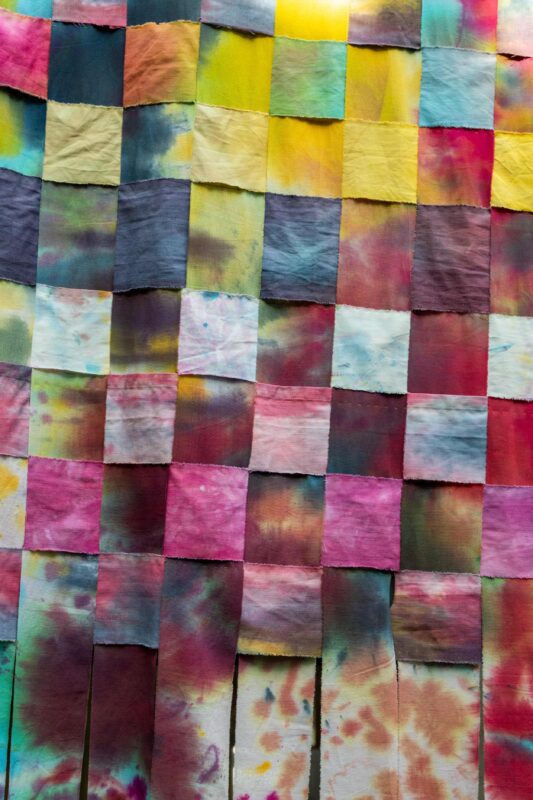
Artist-in-residence
The Danish Arts Foundation’s artist-in-residence programme aims to give children and young people aged 0 to 25 years experience with artistic processes through a course with a professional artist. The scheme is managed by an interdisciplinary committee, and in the new Finance Bill, which was just published in August 2024, the artist- in-residence programme is allocated DKK 11.2 million to continue for the next four years. Link to the programme
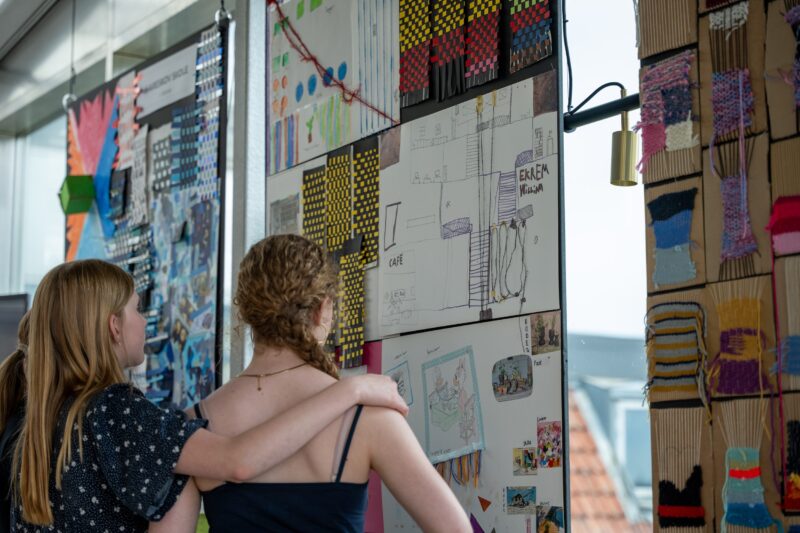
Further reading
Main focus on the process
Tapestry weaver Sanne Ransby needed to ‘drop a bomb’ to pull the students away from their computer screens. Here, along with four other makers, she shares her experiences with the artist-in-residence programme.

Artists-in-residence for Young Audiences – what is it?
The Danish Arts Foundation annually allocates DKK 21 million to projects that provide children and young people with an understanding of what art is. There aren’t many craftspeople and designers who apply for these funds. Designer and head of the Artists-in-Residence committee, Mette Mikkelsen, talks about the program and provides insight into the committee’s wishes.
